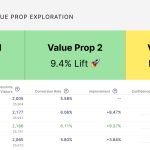Are you finding that customers don’t understand what you offer?
If so, there might be a problem with your Value Proposition and its underlying messages.
People tend to think about conversion in the UX, creative or copywriting sense; but not in terms of MESSAGING.
What do we mean by messaging? It’s the higher-order substance behind the UX, creative or copy.
The importance of messaging
Communicating your product without being clear about the MESSAGING, is like giving a presentation without knowing the point you are trying to make. What’s more, it’s like giving a presentation without knowing your audience or what’s important to them.
Communicating value
- The first step is to unpack the difference between true value (what you have) and perceived value (what they think you have). Value is not one-way, it has to be perceived. If your customers don’t perceive the value in a feature, it doesn’t matter how good you think the feature is.
- List out all the reasons why someone should buy from you and then rank them based on:
1) importance to the customer
2) unique points of difference and exclusivity - Picture a Venn diagram where these two criteria overlap. That’s your sweet spot.
Crafting Messages
- Craft messages from these priorities – the one-two words that sum up the essence.
- Play around with different expressions of the messages. This is how these messages come to life in more detail through words. This is what you would actually say in the copy.
- Your customer’s problem awareness is another thing to consider as it will influence how you communicate.
- Get your customers to help and provide qualitative input before you move to digital. Have a conversation, share the expressions of the messages and let them tell you how they would articulate them.
- Avoid saying things directly, and instead, give your customers the breadcrumbs to conclude themselves. Imagine you are the best at something. Instead of saying “I’m the best”, you would hint at it with claims of superiority.
Validating your message through ads
- Use an ad to validate through metrics what customers tell you through qualitative conversations.
- Ads are a good way to test as they force you to squeeze out the essence of your message. Facebook ads are easy to use and super powerful
- Limit your testing to two to three messages (MAX), with two expressions of each message. That means you will have up to six things to test.
- Especially, in the beginning, aim to test “Black and white” options with enough difference between them, not “shades of grey”
- Aim for about a $1k budget and four to five, one-week tests.
Interpreting results from ads
- Don’t expect to nail it the first time around. If you don’t get amazing results, maybe it’s because you are not expressing the value in the right way. Or perhaps, you expressed it well, but you had the wrong message to begin with.
- You want to get consistent results from several experiments before drawing conclusions.
- Don’t give up and keep testing.
Regardless of how you measure conversion, the overall framework and Scale Messaging’s approach are relevant:
Conversion on Physical Channels:
- Outbound meetings requested to meetings completed
- First meetings to proposal written
- Referrals from past customers to new prospects
Conversion on Digital Channels:
- Visitors taking an action on your site
- Audiences clicking on the CTA of your ad
- Registrations to an event or newsletter
The content above is provided by Leo Cerda from More Traction

